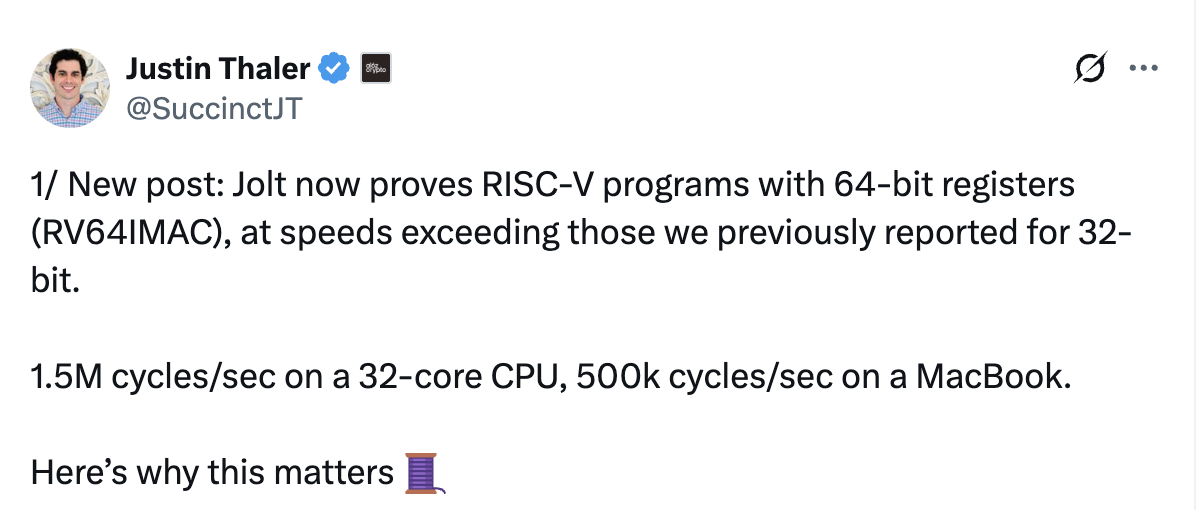IN THIS EDITION:
- How technological progress leads to economic growth — our conversation with Nobel Prize winner Joel Mokyr
- Continuing progress on state-of-the-art zkVM Jolt
- Governments, banks, and even more TradFi embracing crypto…
THE ARGUMENT
Joel Mokyr and Sonal Chokshi
This week, Joel Mokyr, professor of economics and history at Northwestern University, was awarded the Nobel Memorial Prize in Economic Sciences for explaining innovation-driven economic growth. “Stagnation was the norm throughout most of human history,” the committee observed, “Despite important discoveries now and again — which sometimes led to improved living conditions and higher incomes — growth always eventually levelled off.”
But Mokyr identified prerequisites for sustained growth through technological progress, including: useful knowledge, mechanical competence, and institutions conducive to technological progress — as well as the “importance of society being open to new ideas and allowing change”.
a16z crypto’s editor in chief interviewed Mokyr in November 2016, shortly after his book sharing many of these ideas, A Culture of Growth: The Origins of the Modern Economy, was originally published. The book analyzes why Enlightenment culture sparked the Industrial Revolution. Why did the Industrial Revolution take place where it did, and then spread beyond?
It had to do with a competitive, open market of ideas, Mokyr argues — a transnational “Republic of Letters” — not unlike the crypto ethos of open source, decentralization, and more. We’re sharing the full interview with Mokyr here, covering important themes relevant to the crypto industry and beyond, such as:
- going against ancient wisdom, and being able to contest ideas
- the role of trust, collaboration, and credit in collaboration
- competitive markets for ideas, elite vs. access in the printing press vs. the internet
- the role of institutions and emergent organizations
- 2 key ways to drive tech progress
- how to measure progress when technology is dematerialized
- …and more!
read the interview here
PROGRESS UPDATES: R&D
Markos Georghiades, Andrew Milson, Justin Thaler, Andrew Tretyakov, Julius Zhang, and Michael Zhu
State of the art zkVM Jolt now proves RISC-V programs using 64-bit registers, rather than just 32-bit ones. And it does so at speeds exceeding those we reported two months ago for 32-bit programs:
- Over 500,000 cycles/sec on a MacBook
- Over 1,500,000 cycles/sec on a 32-core CPU
Why does 64-bit proving matter? And how did Jolt hit RV64IMAC speeds (cycles/sec), exceeding our RV32IM results from two months ago? read more

Michael Crystal, Guy Goren, Scott Duke Kominers
Decentralized storage is one of the most natural applications built on blockchains, and a central component of the web3 ecosystem. Yet despite a decade of active development — from IPFS and Filecoin to more recent entrants — most of these storage protocols have received limited formal analysis of their incentive properties.
Claims of incentive compatibility are sometimes made, but rarely proven.
This gap matters: Without well-designed incentives, a system may distribute storage but fail to truly decentralize it. So we analyze Shelby — a storage network protocol recently proposed by Aptos Labs and Jump Crypto — and provide the first formal proof of its incentive properties. Our game-theoretic model shows that while off-chain audits alone collapse to universal shirking, Shelby’s combination of peer audits with occasional on-chain verification yields incentive compatibility under natural parameter settings. We also examine coalition behavior and outline a simple modification that strengthens the protocol’s collusion-resilience.
read the just-published paper
NEWS AND MOVES
The Himalayan kingdom of Bhutan integrated its National Digital Identity (NDI) platform with the Ethereum blockchain — “making it the first country to anchor a live, population-scale identity system on a public network”, as reported by Decrypt.
This week, the Office of the Comptroller of the Currency (OCC), a bureau of the U.S. Department of the Treasury that regulates national banks, announced the first de novo bank to receive preliminary conditional approval (Erebor). The Comptroller of the Currency stated that “Permissible digital asset activities, like any other legally permissible banking activity, have a place in the federal banking system if conducted in a safe and sound manner.”
Meanwhile, Bridge CEO shared this week that they submitted an application “for organizing a national trust bank” to the OCC. If the charter is issued, it would allow them to provide custody, stablecoin issuance, management of stablecoin reserves, and more, he said, “under a unified federal framework consistent with the GENIUS Act”.

